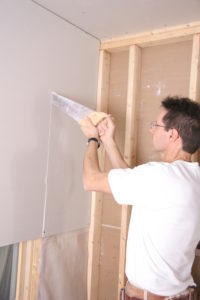By Myron Ferguson

I started doing drywall work around 1980. I know that drywall routers did exist at the time but I did not have one. I did all my cutting with a utility knife, a utility saw and a drywall saw.
I still use my drywall saw quite often because it is fast, convenient, and creates less airborne than a router. Just like when cutting with a router, hang the drywall first just tacking it in place. I cut the vertical edges of door and window rough openings. I then score the top edge with a utility knife and snap and cut away the piece. Always cut from the face side to avoid tearing the face paper. Just guide the saw along the framing while holding the saw square to the drywall face. To avoid breaking the drywall edge and tearing the face paper pull back gently and only cut on the push stroke. This is the same thing you would do when cutting wood with a hand saw, you only cut on the push stroke. The saw is also great for trimming a piece that hangs over the framing edge of an outside corner.
The actual cutting may not be faster than using a router. But because the saw is not attached to an extension cord it can easily be picked up by whoever needs it. The saw is also quite inexpensive so they can be placed around the jobsite prior to hanging for convenience.
The saw is not typically very sharp but there is a pretty good set in the coarse teeth and the blade is quite stiff so it does not bind when cutting.
So of course there is dust but it is not as fine and does not get blown into the air like when cutting with a router.
I find the oscilating tool leaves a cleaner edge on cuts than the saw does (the cleanest cuts are from scoring and snapping the panel). When sawing I tend to end up with very ragged edges, but I assume this is because of my poor technique or a worn saw blade.
When using a drywall you will get best results if you only saw from the good face and only apply pressure when for are pushing the saw to actually cut, when you pull the saw back just relax and don’t apply pressure.
There is SUCH a difference between professional drywalling, and bodge drywalling. ‘This is Drywall’ is a TOP-flight source of info and advice to achieve the best results possible from drywall.
If I may ask a rookie question: Is there a purpose to the darker paper surface of a drywall sheet – or should drywall sheets always be fixed light side into the room? Thank you
Thanks Phil, One side is the finished side and the back is actually a thicker more coarse paper. I guess it could be finished but I don’t suggest doing that.